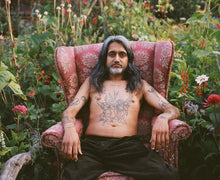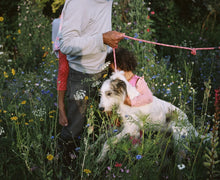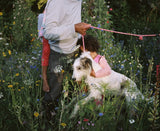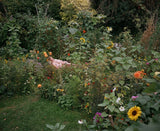34 x 26cm
Hardback clothbound with foiling
112 pages
80 colour illustrations
ISBN 978-1-907112-71-3
Afterword by Jennifer Higgie
*
Trolley are delighted to announce our third publication with Siân Davey The Garden following Looking for Alice (2015) and Martha (2018).
“Why don’t we fill our back garden with wildflowers and bees, and the people we meet over the garden wall – we’ll invite them in to be photographed by you.” This is what my son Luke announced in the kitchen, midwinter, our back garden abandoned for at least ten years. I was sitting at the kitchen table, navigating a family deep in crisis.
What came next was a pilgrimage: an on-going act to cultivate a space grounded in love, a reverential offering to humanity. This is what became The Garden.
In a short window of time, we worked intensively to clear our long-neglected garden. During the process, we intensively researched native flowers, soil and biodiversity. We sourced organic local seeds and sowed under the moon cycles, bio-dynamically.
We offered prayers along the way. We invited the pollinators and nature spirits. Luke and I obsessively shared our dreams, our insights and visions. We called in our ancestors to support and strengthen our vision. We collected stories from the people we met over the garden wall whilst we worked, which soon came to feel like an intimate, confessional space.
We then watched the flowers emerge, silently appearing from every corner of the garden. Mullein, meadowsweet, wild carrot, giant sunflowers and thousands of poppies and cornflowers. We built structures for climbing gourds, tromboncinos, and sweet peas to clamber over.
And as the flowers opened, they called in the community; the mothers and daughters, grandparents, the lonely, the marginalised, teenagers, new lovers, the heartbroken and those that had concealed a lifetime of shame. They became enfolded into the story of the garden, creating and partaking in the story equally.
As the garden evolved it became an expression of joy, interconnectedness, yearning, sexuality, and defiance. The garden became a metaphor for the human heart itself.
Those who entered the garden reflected back to me my history and who I had become.
Everyone has a place in our garden. I am the garden. Those who enter are the garden. Without distinction, without separation.
Siân Davey is a photographer with a background in fine art and social policy, who worked for fifteen years as a psychotherapist. In 2007, following a visit to the Louise Bourgeois retrospective at Tate Modern, London, she was inspired to translate her personal history into creative practice. In 2011, she moved into photography, drawing on her experiences as a psychotherapist and mother to inform her practice, her family and community being central to her work. In 2014, Davey completed an MA in Photography at the University of Plymouth, followed by an MFA in 2016.
Her awards include the Arnold Newman Award for New Directions in Photographic Portraiture, New York (2016), the Prix Virginia, Paris (2016) and the Royal Photographic Society Hood Medal (2017). Her work was selected in three consecutive years (2015 – 2017) for the Taylor Wessing Photographic Portrait Prize exhibition at the National Portrait Gallery, London. She has been a recipient of a W. Eugene Smith Fellowship (2019), commissioned by the Wellcome Photography Prize (2019) and been a nominee for the Prix Elysée (2023).
Her work has been exhibited internationally in both solo and group shows, including at Aperture, New York (2018); Deichtorhallen, Hamburg (2021); Richard Saltoun Gallery, London (2021); and Images Vevey, Switzerland (2022). She is represented by Michael Hoppen Gallery, London.
Davey’s work is held by collections including the Science Museum, London; the Victoria and Albert Museum, London; Centre national des arts plastiques, Paris; and the Martin Parr Foundation, Bristol.
In 2023 she was a Finalist in the Prix Pictet for The Garden, and the work exhibited around the world as part of their touring exhibition at: Victoria and Albert Museum, London; Red Cross Museum, Geneva; Luma Westbaus, Zurich; Fotografiska, Stockholm; Arter, Istanbul; Museum of Photographic Arts, San Diego; Ratskeller, Luxembourg; Pinakothek der Moderne, Munich and Photography Museum Ireland, Dublin.
The Garden is Siân’s third book with Trolley Books following Looking For Alice (2015) and Martha (2018). Looking For Alice was shortlisted for the Paris Photo/Aperture Foundation First PhotoBook Awards (2016) and for the Kraszna-Krausz Foundation Book Awards (2017).
“Why don’t we fill our back garden with wildflowers and bees, and the people we meet over the garden wall – we’ll invite them in to be photographed by you.” This is what my son Luke announced in the kitchen, midwinter, our back garden abandoned for at least ten years. I was sitting at the kitchen table, navigating a family deep in crisis.
What came next was a pilgrimage: an on-going act to cultivate a space grounded in love, a reverential offering to humanity. This is what became The Garden.
In a short window of time, we worked intensively to clear our long-neglected garden. During the process, we intensively researched native flowers, soil and biodiversity. We sourced organic local seeds and sowed under the moon cycles, bio-dynamically.
We offered prayers along the way. We invited the pollinators and nature spirits. Luke and I obsessively shared our dreams, our insights and visions. We called in our ancestors to support and strengthen our vision. We collected stories from the people we met over the garden wall whilst we worked, which soon came to feel like an intimate, confessional space.
We then watched the flowers emerge, silently appearing from every corner of the garden. Mullein, meadowsweet, wild carrot, giant sunflowers and thousands of poppies and cornflowers. We built structures for climbing gourds, tromboncinos, and sweet peas to clamber over.
And as the flowers opened, they called in the community; the mothers and daughters, grandparents, the lonely, the marginalised, teenagers, new lovers, the heartbroken and those that had concealed a lifetime of shame. They became enfolded into the story of the garden, creating and partaking in the story equally.
As the garden evolved it became an expression of joy, interconnectedness, yearning, sexuality, and defiance. The garden became a metaphor for the human heart itself.
Those who entered the garden reflected back to me my history and who I had become.
Everyone has a place in our garden. I am the garden. Those who enter are the garden. Without distinction, without separation.
From Trolley's Website.






















